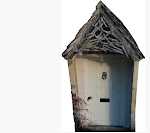 To celebrate the launch of our fourth issue, and to help raise money for our nominated charity Derian House Children's Hospice, we are holding a fantastic competition and offering readers who make a small donation the chance to win one of two fantastic prizes...
To celebrate the launch of our fourth issue, and to help raise money for our nominated charity Derian House Children's Hospice, we are holding a fantastic competition and offering readers who make a small donation the chance to win one of two fantastic prizes...For readers in the UK, the prize is a beautiful, specially commissioned, fairy tale creature called the 'New Fairy Tale Nymph', which has been created by artists Amy Nightingale and Claire Benson of the wonderful Particle Art
 icle (who create the magazine's 'Creatures from the Curiosity Cabinet'). The creature, who has a retail value of £130, will thrive in a fairy tale loving home. We can only offer this prize to readers in the UK for fear that the delicate creature might not survive the ravages of international posting.
icle (who create the magazine's 'Creatures from the Curiosity Cabinet'). The creature, who has a retail value of £130, will thrive in a fairy tale loving home. We can only offer this prize to readers in the UK for fear that the delicate creature might not survive the ravages of international posting. I hope readers outside the UK won't be too disappointed though, for them the prize on offer is a beautiful hardback illustrated fairy tale called Ream, by paper artist Oona Patterson, whose work features on the front cover of, and inside, the new issue. Oona's delicate papercuttings are truly enchanting and this is a wonderful book (I know because I have a copy). Oona has also signed a lovely postcard which will fly to the winner too.
I hope readers outside the UK won't be too disappointed though, for them the prize on offer is a beautiful hardback illustrated fairy tale called Ream, by paper artist Oona Patterson, whose work features on the front cover of, and inside, the new issue. Oona's delicate papercuttings are truly enchanting and this is a wonderful book (I know because I have a copy). Oona has also signed a lovely postcard which will fly to the winner too.So, if you'd like to enter: first, to be eligible, you need to make a small donation to Derian House via our JustGiving page here - this is quick, totally secure and all major cards are accepted (from inside and outside the UK). The minimum donation the site accepts is £2. Please note that because your donation is linked to a competition it won't be eligible for GiftAid so make sure you tick the boxes appropriately. Then, and this is really important, you must come back here and fill out your name, email address and country on the form I've linked to below, JustGiving doesn't automatically send all of your details to me so if you don't do this you can't be entered. I will use your details only to enter you into the competition, they will not be passed to anyone else, and will be securely deleted once the competition has been drawn. Please don't fill out this form unless you've made a donation.
The form is here:
http://newfairytales.co.uk/tinc?key=YAgOl70g&formname=competition
The competition will close to entries at midnight GMT on the 30th December. The draw will be made in front of witnesses on the evening of 31st December and the winners will be notified by email on the 1st January 2010.
If you've got any questions please feel free to post a comment below or email me.
Thanks,
Claire














